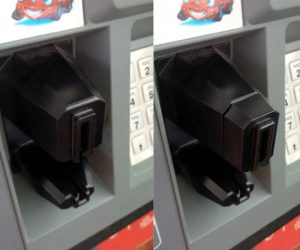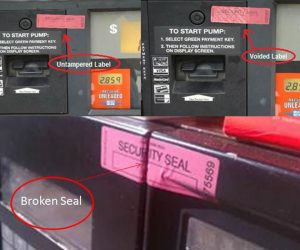It may be time to add fuel stations where you pay-at-the-pump, to the list of places you simply do not use a debit card. Over the past few years, fraudulent debit card activity has taken the form of fuel station scams that use technology to victimize customers. Scammers are able to use two different techniques to steal credit and debit card data and both are increasingly difficult for consumers to detect, until finding discrepancies on account statements that follow.
The Nolan County Sheriff’s Office is encouraging citizens to remain vigilant for card skimming devices on fuel pumps, and practice the following security measures to avoid falling victim to such devices. Additionally, we are asking area fuel stations to regularly check their gas pumps and report any suspicious activity to law enforcement.
Two types of skimmers

 External skimmers (left) fit temporarily over the actual card reader on the fuel pump, and are usually accompanied by a hidden camera or keypad overlay. When the consumer swipes a debit card, it can steal the data and capture the PIN.
External skimmers (left) fit temporarily over the actual card reader on the fuel pump, and are usually accompanied by a hidden camera or keypad overlay. When the consumer swipes a debit card, it can steal the data and capture the PIN.
Internal skimmers (right) are attached inside of the fuel pumps which make them undetectable to the customer or store employees. They typically are made of a simple cable with an in-line recording device that runs between the card reader and the main board. It also records the card data, which is later retrieved.
Playing defense
 If possible, use fuel pumps closest to the building or in clear view of the attendant. When attaching skimming devices, criminals avoid being seen and will often target pumps where employees have obstructed views.
If possible, use fuel pumps closest to the building or in clear view of the attendant. When attaching skimming devices, criminals avoid being seen and will often target pumps where employees have obstructed views.
Before using a fuel pump, check for an external skimming device. They are typically attached using only double-sided tape, so criminals can easily remove them. Before you swipe your card, verify that the card readers on other fuel pumps are the same; tug on the reader to ensure it is securely attached; these types of skimmers will easily pop off with little effort.
Check for a hidden camera typically located where it can record both the keypad and your fingers as you enter your PIN. In cases where a small camera is not used, there will be a keypad overlay fitted on top of the legitimate keypad. The overlay captures the PIN, bypassing the need for a camera.
Check for indicators of a possible internal skimming device. Survey the edges of the fuel pump, especially the access panel surrounding the card reader unit. If it looks damaged, as if it’s been pried open, protruding wires or if the lock itself is broken, it may be compromised. Some fuel stations apply tamper-resistant seals on card reader access panels. When an access panel door has been broken into, the seal is lifted revealing the words “VOID.”
If you find an external skimmer or a broken tamper proof seal, immediately notify the attendant, and contact your local law enforcement agency to file a police report; this is a necessary step to ensure that the device is removed from the pump and prevent other customers from having their card data stolen.
Another defense is to closely monitor bank and credit card statements, and look for any discrepancies. Criminals often use stolen credit card numbers to make small purchases ensuring it will work before racking up large amounts of money.
When purchasing fuel, it is recommended that citizens always pay with cash and avoid using debit cards. Using a credit card, rather than a debit card at pay-at-the-pump fuel stations will provide an extra level of protection. Fraudulent charges on your credit card are usually limited to no more than $50 if promptly reported. But a criminal with access to your debit card data can clean out your bank account. Some banks have policies that limit consumer losses in the event of this kind of fraud, but policies vary from bank to bank.
Meanwhile, it’s best to avoid getting entangled in this kind of fraud, regardless of the payment type you are using.